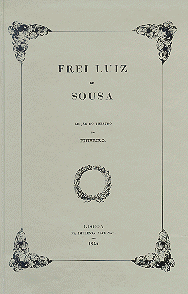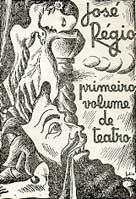
|
|
|
| History of Portuguese Literature | Origins of Portuguese Literature | The Portuguese Language | Oral Literature | Fiction | Lyricism |
| Travel Literature | Cantigas de amigo | Historiography | Doctrinal Prose | ||
Theatre
|
|
Any
discussion of Portuguese theatre depends on two previous considerations:
1.
Reflecting upon the
nature of the relationship between theatre and literature (because traditionally
drama studies are part of literature, given the insistence on the text as a
dramaturgic material that pre-exists the performance or, in those many cases
where performance precedes publication, given its material perpetuity resulting
from the various performances that it supports);
2. Bearing in mind
that many historians consider that theatrical activity is not a major aspect of
Portuguese culture (neither at the level of the text nor at the level of the
performance).
 Front cover of an edition of the play Frei Luiz de Sousa by Almeida Garrett, facsimile of the Quinta do Pinheiro edition  Front cover of Primeiro Volume de Teatro by José Régio, 1940, drawing by Júlio |
This
probably explains why the leading figures in Portuguese theatre are either
inaugural or programmatic: Gil
Vicente, the creator of Portuguese theatre in the sixteenth century,
after the notable increase in liturgical dramatisations in mediaeval literature,
and Garrett,
who reformed it along romantic lines and founded the National Theatre. This
represented a space that was suited for putting on performances in front of
larger audiences and led to the production of a “corpus”, with Um
Auto de Vicente, O Alfageme de Santarém and, above all, the romantic drama Frei
Luís de Sousa (1843) - plays of a historical nature, drawn from popular
feelings and patriotic sentiments, conveying emotional conflicts acted out
against the backdrop of the socio-historical everyday life in Portugal.
Inspired by the success of Gil Vicente,
other playwrights (e.g. Chiado and Baltasar Dias)
established reputations for themselves in the sixteenth century, yet at the same
time there was a powerful movement in favour of a return to ancient classical
theatre, based on the Renaissance doctrine. This led to the emergence of another
group centred around the poet Sá de
Miranda, who became a fundamental figure in Portuguese classicism through
his introduction of the “new measure” (classical metrification in
decasyllables and genres cultivated by the classical authors) and his promotion
of the first classical comedies, Estrangeiros
and Villhalpandos.
Comedy, which was also written by Camões
(e.g. Anfitriões, El-rei
Seleuco), was to find a major exponent in the eighteenth century, António
José da Silva, the Jew (e.g. Guerras
do Alecrim and Manjerona), as well
as some writers from the “Arcádia Lusitana”, such as Correia Garção (Assembleia
ou Partida).
António Ferreira
was responsible for the masterpiece of classical tragedy in Portugal, Castro
(c. 1558), based on the love of D. Inês de Castro for D. Pedro I, which was
opposed for political reasons. Castro
and Frei Luís de Sousa are the two most important tragic texts in
Portuguese theatre, noted for the perfection of their composition and the sober
development of their conflicts, which are divided between the freedom of
feelings, the demands for justice (whether political, civil or family justice)
and the intensity of the fate which befalls the characters.
It was not until the twentieth century that we were to find dramatic atmospheres
of similar tension and intensity in plays by José
Régio (Benilde ou
a Virgem-Mãe, 1947) or, shortly before this, in the work of Raul
Brandão (O Gebo e a Sombra,
1923). This latter play expresses the passivity and static quality of the
symbolist problematics, centred on the resonance of the lyrical word and the
investigation of the absolute (António
Patrício, D. João e a Máscara,
1924). Such concepts were differently understood by the conventionalism of
situations and customs that had been introduced by the copious works of Marcelino
Mesquita (Peraltas e Sécias,
1899) and Júlio Dantas (A Ceia dos Cardeais, 1902), or by the irregular and ambiguous
innovations, of both a social and textual nature, introduced by Alfredo
Cortês (Tá-Mar, 1936).
The appearance of interventionist literature in the nineteen fifties breathed
new life into the theatre, especially with the works of Bernardo Santareno (A Promessa,
1957, and O Crime de Aldeia Velha,
1959), Luiz Francisco Rebello (Os
Pássaros de Asas Cortadas, 1959, this same writer also producing important
work as a theatre critic and historian) and José
Cardoso Pires whose O Render
dos Heróis (1960) was first performed shortly before another play that had
a major public impact, Felizmente, Há
Luar (1961), by Luís de Sttau
Monteiro. All these works brought great intensity to Portuguese theatre in
the middle of the century through their creation of a definite interplay between
text, performance, audience and critics, which has not been seen since.
© Instituto Camões, 2001